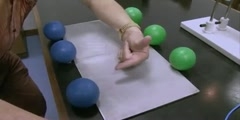Lec 10 - Physics 111: Hall Effect In A Plasma (HAL)
Physics 111: Hall Effect In A Plasma (HAL) Physics 111 Advanced Laboratory. Professor Sumner Davis This video accompanies the Hall Effect In A Plasma Experiment, providing students with an introduction to the theory, apparatus, and procedures. The Hall effect is the phenomenon of a voltage developing across two boundaries in a direction transverse to the current flow in a system of charged particles in a magnetic field owing to the Lorentz force q(v x B). In this experiment you will measure the Hall voltage as a function of current, magnetic field strength, and gas pressure in a gaseous discharge tube. These data are then used to determine the density and mean speed of free electrons in the system. This experiment requires a review of electricity and magnetism, thermal physics, and atomic physics. It is also an excellent introduction to plasma physics http://advancedlab.org
Video is embedded from external source so embedding is not available.
Video is embedded from external source so download is not available.
Channels: Physics (General)
Tags: Physics 111: Hall Effect In A Plasma (HAL)
Uploaded by: berkeleyphy111 ( Send Message ) on 19-09-2012.
Duration: 12m 58s
Here is the next lecture for this course
Lec 35 - Physics 111: Hall Effect In A Se ...
01:00:57 | 4622 viewsRice University Physics and Astronomy: Sp ...
05:37 | 7345 viewsWhat is Hall Effect?
06:13 | 6817 viewsLec 2 - Physics 111: Atomic Physics (ATM) ...
32:01 | 5348 viewsLec 13 - Physics 111: Josephson Junction ...
19:03 | 4509 viewsLec 13 - AST 210/EE 213 Plasma physics
01:23:30 | 3560 viewsLec 14 - AST 210/EE 213 Plasma physics (c ...
01:20:02 | 2876 viewsLec 24 - 8.01 Physics I: Classical Mecha ...
50:08 | 2148 viewsLec Last- 8.01 Physics I: For the Love of ...
01:01:26 | 3266 viewsLec 8 - Physics 111: Compton Scattering (COM)
20:27 | 4033 viewsLec 9 - Physics 111: Gamma Ray Spectrosco ...
27:59 | 3857 viewsLec 16 - Physics 111: Atomic Physics (ATM ...
37:43 | 3458 viewsLec 24 - Physics 111: Non-Linear Spectros ...
01:01:25 | 4467 viewsLec 25 - Physics 111: Non-Linear Spectros ...
34:46 | 3875 viewsLec 29 - Physics 111: Nuclear Magnetic Re ...
18:22 | 5162 viewsNo content is added to this lecture.
This video is a part of a lecture series from of berkeley
















